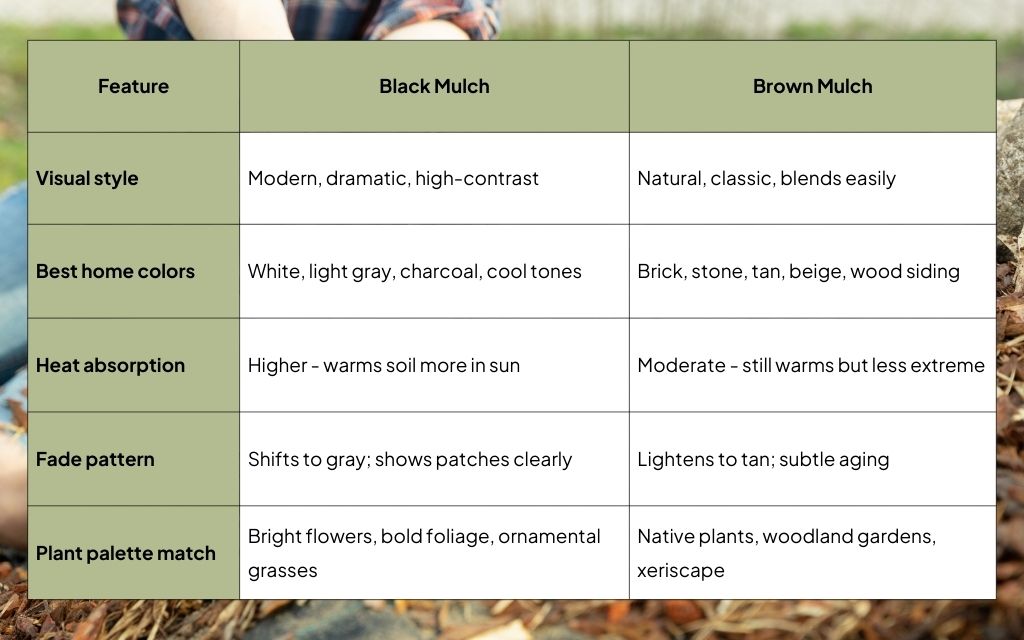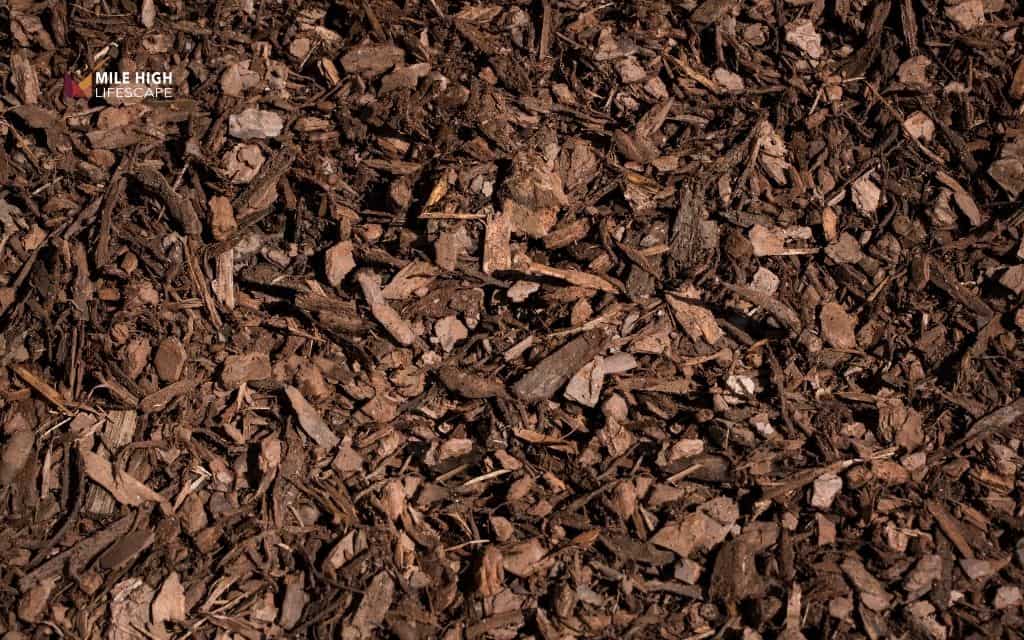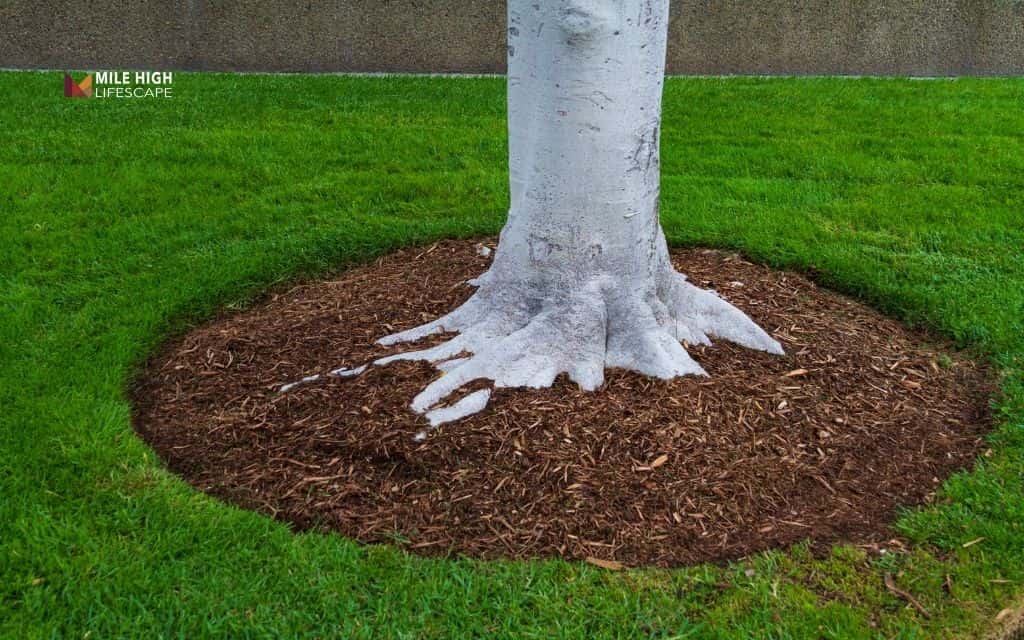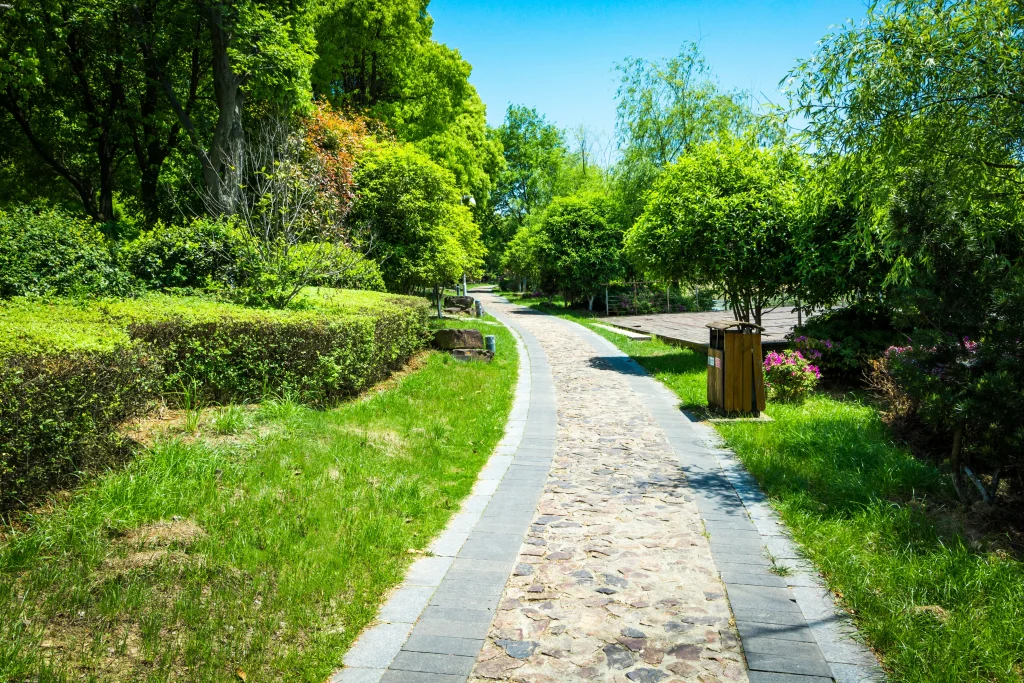Black or brown mulch and which one is better than the other? This question matters more than most homeowners realize. Black and brown mulch both suppress weeds, conserve moisture, and protect plant roots from Denver’s temperature swings.
The difference shows up in appearance, heat absorption, how they fade, and whether they match your home’s style. Choose wrong, and your beds look off. Choose right, and your landscape gains instant polish.
This guide gives you clear answers. You’ll learn which mulch color works with your home exterior, your plants, and our high-altitude climate. By the end, you’ll know exactly which mulch belongs in your yard and why.

What is black mulch?
What it’s made of
Black mulch starts as shredded wood or bark. Manufacturers dye it with dark colorants – usually carbon-based blacks or charcoal. The base material can be hardwood, softwood, or recycled wood products. Reputable suppliers use clean wood and safe dyes. Cheap black mulch may contain treated lumber or unknown additives.
Visual impact
Black mulch creates bold contrast. It makes green foliage brighter and causes flower colors to pop. A bed of petunias or marigolds against black mulch looks striking.
This high-contrast effect works well in modern landscapes, minimalist designs, and contemporary Denver homes with clean lines. Black mulch says “designed” rather than “natural.” It draws the eye and commands attention.

What is brown mulch?
What it’s made of
Brown mulch typically comes from natural wood or bark. Some versions get a light dye treatment to deepen the color or maintain consistency across batches. Many brown mulches use hardwood like oak or hickory. Others rely on pine bark or cedar.
The natural versions break down over time and enrich the soil. Dyed brown mulch holds its color longer than raw wood but still fades gradually under sun exposure.
Visual impact
Brown mulch delivers a classic forest floor look. It blends naturally with most landscapes and doesn’t demand attention. This mulch works across almost every Denver home style – traditional bungalows, craftsman architecture, mountain-inspired designs, and rustic properties.
Brown feels warm and organic. It lets plants take center stage rather than competing for visual priority. Most landscapers consider brown the safest, most forgiving choice for residential landscapes.

Black or brown mulch: Quick comparison
| Feature | Black Mulch | Brown Mulch |
| Visual style | Modern, dramatic, high-contrast | Natural, classic, blends easily |
| Best home colors | White, light gray, charcoal, cool tones | Brick, stone, tan, beige, wood siding |
| Heat absorption | Higher – warms soil more in sun | Moderate – still warms but less extreme |
| Fade pattern | Shifts to gray; shows patches clearly | Lightens to tan; subtle aging |
| Plant palette match | Bright flowers, bold foliage, ornamental grasses | Native plants, woodland gardens, xeriscape |
Neither color wins universally. One will clearly fit your specific home, plants better than the other.
Aesthetic showdown: Which looks better where?
Match to home exterior color
Your home’s exterior determines which mulch color creates harmony or clashes.
Black mulch works best with white houses, light gray siding, charcoal accents, and cool-toned exteriors. It pairs naturally with modern stucco, painted brick, and sleek hardscape materials like concrete pavers or metal edging. The contrast amplifies architectural lines and creates a contemporary feel.
Brown mulch suits brick homes, stone facades, tan stucco, beige vinyl, and wood siding. Traditional bungalows, craftsman-style houses, and mountain-inspired properties look better with brown.
The warm tones complement natural building materials rather than fighting them. If your house features red brick, brown mulch echoes the earth tones already present. If you have log accents or wood trim, brown mulch extends that organic palette into the landscape.
A simple test: look at your house from the curb. If it reads “cool and modern,” start with black. If it reads “warm and traditional,” start with brown. Mismatching these creates visual tension that makes the landscape feel disconnected from the home.
Match to plant palette
Black mulch makes bright colors explode. Petunias, marigolds, zinnias, and red salvia look stunning against black. Vibrant green hostas, ornamental grasses, and bold foliage plants gain definition. This mulch works when you want plants to be the stars and the soil to recede into the background. The contrast creates drama and makes beds look intentionally designed.
Brown mulch serves naturalistic plantings better. Xeriscape gardens with native grasses, wildflowers, and drought-tolerant perennials look more cohesive with brown. Woodland gardens featuring ferns, columbines, and shade perennials feel appropriate with brown tones.
If you’re mimicking Colorado’s natural landscapes – the foothills, the mountain forests, the prairie edges – brown mulch supports that illusion. Black would break it.
Landscape style & mood
Your landscape carries a mood, whether you planned it or not.
Modern landscapes with clean edges, geometric beds, and minimalist plant choices benefit from black mulch. The sharp contrast reinforces the designed, intentional nature of the space. High-end curb appeal often relies on this dramatic look.
Traditional landscapes with curved beds, mixed borders, and layered plantings pair naturally with brown mulch. The warm, organic feel supports a cozy, “Colorado cabin” aesthetic.
Neither mood is superior. Your home, your neighborhood, and your personal taste determine which fits. Walk your street. Notice which mulch colors appear in the best-maintained yards. That often reveals what works in your specific microclimate and architectural context.
Cost & maintenance: Black vs brown over time
Upfront cost
In most Denver landscape supply yards, black and brown dyed mulches cost roughly the same per cubic yard. Prices typically range from $30 to $60 per yard, depending on material quality and supplier.
Natural brown mulch sometimes runs slightly cheaper than dyed versions. Exotic options like red cedar or dark walnut mulch cost more regardless of color.
Budget about the same initial investment for either black or brown. The real cost difference emerges over time in maintenance and refresh frequency.
Refresh frequency & appearance
Black mulch shows wear faster in Denver. Our high-altitude sun bleaches dark pigments quickly.
Black shifts to gray, often unevenly. Within 12 to 18 months, many black mulches look patchy. Fresh black against faded gray creates an obvious maintenance problem. You’ll need to top up more often – or accept a mottled appearance.
Brown mulch fades too, but the shift from dark brown to lighter tan reads as natural aging rather than neglect. A light one-inch top-up each spring refreshes the color without the stark contrast you get when adding fresh black to faded gray. Brown’s fade pattern is more forgiving and blends more easily when you add new mulch.

Climate condition: Black vs brown mulch in Denver
Heat & Sunlight at High Altitude
Denver sits at 5,280 feet elevation. The atmosphere here is thinner, which means more UV radiation reaches the ground. Our sun is intense. It fades paint, cracks plastic, and bleaches fabric faster than at sea level. It does the same to mulch.
Black mulch absorbs more heat than brown. On a hot afternoon, black mulch in full sun can reach temperatures that stress shallow-rooted plants. If you plant delicate perennials or newly installed shrubs in these spots, black mulch may cook the roots near the surface.
Brown mulch still warms the soil – all mulch does – but the effect is less extreme.
This doesn’t mean black mulch kills plants. Many gardeners use it successfully. But if you’re planting heat-sensitive species in brutal sun exposure, brown offers a safer margin.
Fade & Color Longevity
Both dyed black and dyed brown mulches fade under Denver’s sun. The difference lies in how that fade looks.
- Black-to-gray feels harsh. It creates a two-tone effect that reads as “old and neglected” rather than “naturally weathered.”
- Brown-to-tan blends more gracefully. Light top-ups of fresh brown mulch integrate easily with the faded base layer. You can stretch the time between full mulch replacements.
If you choose black, plan to refresh it more often. If you choose brown, you buy yourself more flexibility. For busy homeowners, that flexibility often matters more than the initial color preference.
Soil, plants, and performance – any real difference?
Do black and brown mulch perform differently for plant health?
No. If black and brown mulch come from the same base material, say, shredded hardwood, they perform identically for plant health.
Color doesn’t change moisture retention, weed suppression, or soil temperature buffering in any significant way. A two-inch layer of black mulch and a two-inch layer of brown mulch deliver the same functional benefits.
The base material matters far more than color. Hardwood mulch breaks down slower than softwood. Composted mulch enriches soil faster than raw wood chips. Fine shredded mulch mats down and may repel water. Coarse nuggets allow better air circulation. These differences affect plant health. Color does not.
Focus on material quality first. Then choose black or brown based on aesthetics and maintenance comfort.
Safety & material quality
Not all mulch is created equal. Some suppliers use clean, untreated wood and safe carbon-based dyes. Others use recycled construction lumber that may contain chemicals from pressure treatment or painted surfaces. Always ask your supplier about material sources.
Reputable landscape supply companies in Denver sell clean, safe mulch. If a price seems too good to be true, ask questions. Cheap mulch may contain contaminants that leach into your soil or harm beneficial organisms.

________
Mile High Lifescape sources mulch from trusted local suppliers. We verify material quality before installation. Our nearly 20 years of experience in the Denver Metro area taught us which products perform well and which cause problems.
If you’re looking for a professional mulch installation service, call us at (303) 877-9091 or email hello@milehighlifescape.com. We’re happy to point you toward reliable sources.
Conclusion
Black mulch works beautifully in some Denver landscapes and looks out of place in others. Brown mulch creates harmony in most settings but may feel bland in modern, high-contrast designs.
Your decision rests on 3 factors: your home’s colors, your plants and sun exposure, and your style and maintenance comfort. Match mulch to your house exterior first. Consider your plant palette second.
If you’re unsure, choose mid-to-dark brown. It’s the most forgiving, timeless option. It works across nearly every architectural style, plant combination, and maintenance schedule. You can always experiment with black in a small area later if you want more drama.
If you want bold modern contrast and can manage slightly more maintenance, black mulch looks incredible in the right Denver setting. Pair it with the right home colors and bright plants, and you’ll create eye-catching curb appeal that neighbors notice.
Frequently asked questions (FAQs)
Is black or brown mulch better overall?
Neither is universally better. Both suppress weeds, conserve moisture, and protect roots equally well. Brown mulch suits traditional Denver homes and blends naturally with most landscapes. Black mulch creates bold contrast and works best with modern architecture and bright flowers. Choose based on your home’s exterior and how much maintenance you’ll handle.
Which lasts longer: black mulch or brown mulch?
Both last 2-5 years before needing full replacement. Brown shows less visible aging in Denver’s sun. Black fades to gray within 12 to 18 months, creating patchy appearance. Brown fades to lighter tan, which looks more natural. You can stretch brown mulch longer between top-ups without the landscape looking worn.
Does black mulch make the soil too hot in Denver?
Black mulch absorbs more heat than brown. It can stress shallow-rooted plants beds during hot afternoons. Brown mulch warms soil less extremely. Choose brown for delicate plants in brutal sun exposure. Black works fine in north-facing beds or spots with afternoon shade.
Is dark brown mulch a good compromise between black and brown?
Yes. Dark brown offers visual richness like black but fades more gracefully and retains less heat. It creates better contrast than natural brown without harsh aging. Dark brown works with both warm and cool-toned homes and pairs well with varied plant palettes. It’s dramatic enough to add polish but forgiving enough to tolerate Denver sun.
Does either color attract more pests or mold?
No. Color doesn’t affect pests or mold. Mulch material and moisture levels do. Both colors can develop harmless surface mold during decomposition. Termites and carpenter ants are attracted to moist wood regardless of color. Keep mulch two to three inches from your foundation and avoid piling it against tree trunks.
Can I switch from black to brown (or vice versa) without removing all the old mulch?
Yes. Top faded mulch with 2 to 3 inches of new color. Switching from black to brown works better than brown to black because lighter tones cover faded gray more easily. If old mulch is severely decomposed or uneven, removing it creates cleaner results.
